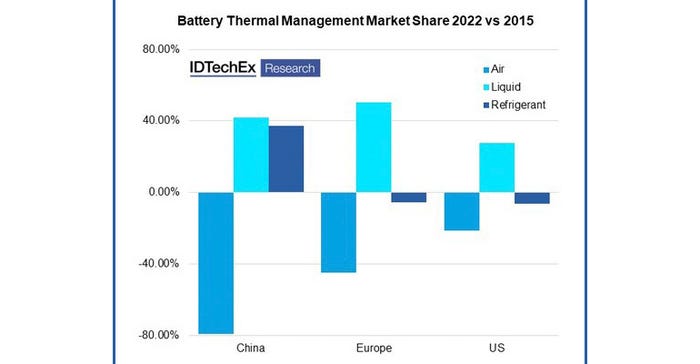The New Opportunities in EV Battery Thermal Management
The new thermal management for EVs report from IDTechEx analyzes the EV market and the thermal management strategies adopted by OEMs and their suppliers.
December 23, 2022

Thermal management continues to be a key topic for electric vehicle (EV) battery design. Early trends in the market largely revolved around the adoption of active cooling for the battery pack, and now this is the industry standard.
However, batteries, motors, and power electronics in EVs continue to evolve, with developments of cell-to-pack designs, directly oil-cooled motors, and silicon carbide (SiC) power electronics being just a few of the key trends that will impact thermal strategies across the key driveline components in an EV. As the thermal management market evolves, opportunities arise for materials companies, component suppliers, vehicle designers, and other players in the rapidly growing EV industry.
Battery Design Trends
The key factors for EV battery development are increasing energy density and reducing costs. This has been made more difficult with supply chain shortages and rising costs of materials, but battery designs are becoming simpler as designers start to remove materials that are not the cells. This strategy culminates in cell-to-pack or cell-to-body designs.
Cell-to-pack eliminates strict module housings in favor of having all of the cells stacked together. Cell-to-body makes the battery a structural part of the vehicle. Designs have made it onto the road, with further announced designs coming to market in the near future. With the removal of so much from the pack, how does this impact thermal management?
Active Cooling and Market Trends
Some active cooling strategies will remain similar, with a large cold plate beneath or above the cells, albeit now in contact directly with cells rather than their module housing. The bigger change comes from larger form factor cells becoming more common in cell-to-pack designs. The larger form factor means that less induvial cells per pack are required.
Examples of this can be seen in BYD's Blade battery with very long prismatic cells or in Tesla's use of the larger cylindrical 4680 cells. These changes mean that less individual coolant channels are required compared to previous designs. BYD uses one large cold plate across the top of the pack, and Tesla can now use 12 coolant lines for side wall cooling cells compared to the 28 previously used in the 2170 packs.

The transition to active liquid battery cooling has happened quicker than many, including IDTechEx, had originally predicted. In the first half of 2022, over 70% of the electric car market was using liquid cooling. The benefits of greater thermal performance and integration with the whole vehicles thermal management system have outweighed the reduced complexity of air cooling. However, we have seen greater refrigerant cold plate cooling adoption, gaining a 6.5% greater market share in 2022 over 2021.
While typical automotive coolants and refrigerants have been used to date, there is gathering interest in tailoring these coolants to EVs, with lower electrical conductivity as one of the new features. IDTechEx's new report forecasts the adoption of air, liquid, refrigerant, and immersion cooling for EV batteries in terms of kWh demand.
Thermal Interface Materials
Design integration also has a severe impact on thermal interface material (TIM) utilization, pushing in favor of thermally conductive adhesives to make a structural connection rather than the typical gap filler seen in many existing designs. The new IDTechEx report includes forecasts for gap pads, gap fillers, and thermally conductive adhesives in EV batteries.
About the Author(s)
You May Also Like





